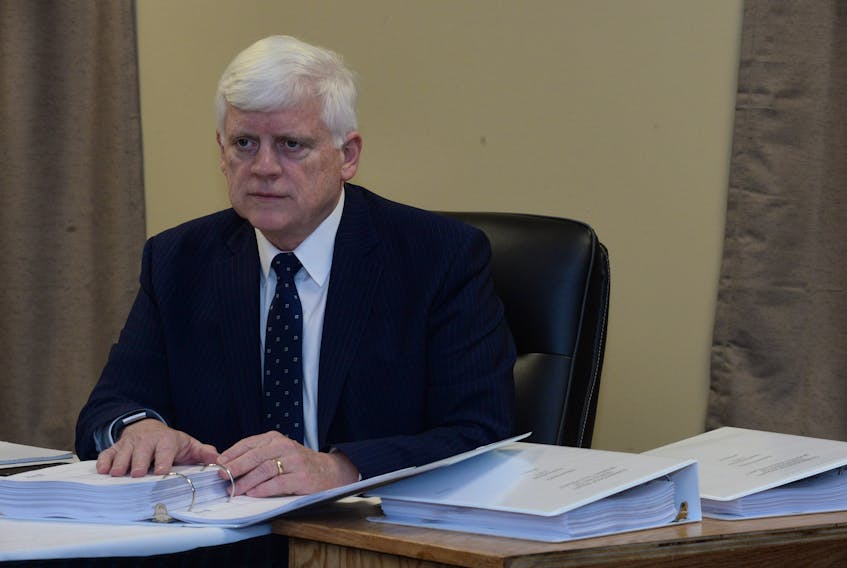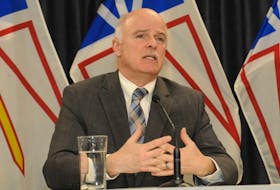ST. JOHN'S, N.L. — When Ed Martin was on the stand at the Muskrat Falls Inquiry earlier this month, he was accused of creating a last-minute story around project risk, and how he budgeted for the possibility of overruns in cost and schedule.
He offered a step-by-step explanation of his consideration of risk, and why the project schedule put to government in 2012 was not one guaranteed to fail.
He believed the schedule was aggressive, but could be done. Where did he feel support for that? The official word from SNC-Lavalin was first power in 2017 was possible. Manitoba Hydro International was willing to put the company name on a report saying it was possible. Lead members of his own project team, including project director Paul Harrington have testified to believing it possible.
On the other hand, witnesses like John Mallam (who worked on an internal review) and Richard Westney (of Westney Consulting), have testified of the need for a new schedule or added reserve.

Different lawyers and witnesses have referred to sanctioning the Muskrat Falls Project on a very slim one per cent or three per cent chance of meeting schedule (sometimes it’s mentioned as a “probability factor,” P factor). It comes out of quantitative risk analysis (QRA) work by Westney Consulting in 2010 and 2012. The reports are a management tool. Martin says the work was specifically ‘stressing’ the schedule — seeing what would happen if worst-case scenarios piled up.
He told The Telegram any suggestion he pressed ahead with certainty of a failed schedule and cost overruns is “ridiculous.”
Inquiry co-counsel Barry Learmonth was not impressed by the former CEO’s comments on the Westney review work, or on reports from EY and Grant Thornton. He said Martin hadn’t taken the opportunity to challenge relevant witnesses.
“And then you come in at the end, after most of the people have testified and come up with this theory. You’re entitled to do that (…) but I think it may bring into question a lot of things,” Learmonth said.
Martin said there were points raised along the way. He believed other project management team members’ testimony would match his own understanding and end talk of a “P1” schedule. Finally, he said his lawyer objected privately to the “P1” references, and the message was he would have his day.
It also wasn’t the first time Martin stated his positions.
“You know, a ‘time risk analysis’ is a document, and an entirely separate document is the schedule,” he told former inquiry co-counsel Kate O’Brien, when he was on the witness stand in 2018.
“So I do not equate time-risk analysis to schedule. And where I’m going with that — and I’ve been clear on this, you know, in my own mind and in the company — is that this is not a P1 schedule. We did not sanction — although this is decision gate two [being before the final estimates] — I’m going to say we did not sanction on a P1 schedule.”
He repeatedly interjected with O’Brien to reject the premise, whenever she mentioned a P1 schedule. He made the point there were steps taken to de-risk the project before sanctioning, including getting heavy civil works approved for an early start in 2011. Apart from that, the Westney analysis was on a six-day and not seven-day schedule. Martin said his understanding was it allowed for as much as an eight-month float.
“This (project) schedule was developed based upon, what was considered at the time to be, realistic, benchmarked and externally validated concrete pour sizes and placement rates, which was in turn aligned with those in the Base Estimate. An approximate 15 per cent (1 day per week) non-productivity allowance was built into the schedule,” states a highlighted Nalcor Energy document in evidence.
Nalcor Energy executive vice-president Gilbert Bennett, who was Martin’s number one, recalls the project team’s internal cost forecasts began coming in higher than the official estimates. Martin opted not to communicate them to the Nalcor board of directors or to the government. Bennett said that was Martin’s decision to make.
Bennett testified Friday, saying he had full faith in Martin’s understanding of risks. He deferred to Martin in discussions on the subject of capital cost, investment requirements and funding requirements.
“The management reserve deals with future risk,” Bennett said. “In multiple meetings, I’ve heard Mr. Martin explain what those risks are. They weren’t necessarily quantified, but he certainly discussed the nature of risks associated with the project.”
From 2012 to 2016, beyond financial close and into the construction, there was no further qualitative risk assessment undertaken. That was acknowledged by Bennett, who said the assessments were only a management tool.
He didn’t see the value in the studies during periods of upheaval with specific contractors, including Astaldi Canada. At those points, he said, he knew where the project team needed to focus.
While EY recommended more QRAs, in work for the Muskrat Falls Oversight Committee, Bennett said the studies can become cases of “garbage in, garbage out” and there are other ways during construction to help determine where you stand on cost and schedule.
Decisions around risk assessment, management reserve and changing budgets are discretionary, rather than dictated by a standard.
“We don’t have a cookbook that says if you do a QRA every six months everything would work out fine,” Bennett said.
It will be left to Commissioner Richard LeBlanc to weigh the executive decisions.
Bennett’s testimony is not complete. He was scheduled over three days, with Friday being the first day, followed by Tuesday and Wednesday. The inquiry is not scheduled to sit on Monday, Discovery Day.
RELATED
A look ahead
There are two weeks left in the scheduled public hearings for the second phase of the Muskrat Falls Inquiry. The witness list is published online, and remains subject to change.
A schedule for the final phase of hearings has yet to be released, and will be followed by final submissions, currently still expected in early August. A final report is due by the end of the year.
- June 25, 26 – Gilbert Bennett
- June 27 – Siobhan Coady
- June 28 – Jennifer Fiddian-Green (Grant Thornton), followed by Stan Marshall
- No hearing Canada Day
- July 2, 3 – Stan Marshall
- July 4, 5 – Dwight Ball
(Source: muskratfallsinquiry.ca)









